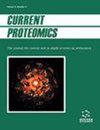A bottom-up proteomic approach in bone marrow plasma cells of newly diagnosed multiple myeloma patients
IF 0.5
4区 生物学
Q4 BIOCHEMICAL RESEARCH METHODS
引用次数: 0
Abstract
Multiple myeloma (MM) is characterized by infiltration of bone marrow (BM) with clonal malignant plasma cells. The percentage of plasma cells in the BM is required for both diagnosis and prognosis. Intracellular protein screening and quantitative proteomic analysis was performed in myeloma plasma cells with an aim to compare expressions between low (0-9%), intermediate (10-20%) and high (>20%) plasma cell infiltration groups. BM aspiration samples were collected from newly diagnosed untreated patients with MM. The samples were pooled into three groups according to the plasma cell content (PCC) in the BM: group 1 (0-9%), group 2 (10-20%) and group 3 (>20%). Protein profiles were obtained and proteins were identified by peptide mass fingerprinting analysis. Differentially expressed proteins were detected between all groups. The identified proteins are Endoplasmin, Calreticulin, Protein Disulfide-isomerase, Marginal zone B and B1 cell specific protein/pERp1, Actin cytoplasmic 1, Myeloblastin, Thioredoxin domain-containing protein 5, Ig kappa chain C region, Apoptosis regulator B-cell lymphoma 2 and Peroxiredoxin- 4. Proteins involved in cell proliferation, apoptosis, redox homeostasis and unfolded protein disposal through endoplasmic reticulum-associated degradation machinery has been found to be correlated to PCC. Our results confirm earlier reports in regards to the potential effects of identified proteins in the major signaling pathways that lead to cancer. Moreover, this study reveals a novel association between PCC levels and MM. It further highlights the roles of Marginal zone B and B1 cell specific proteins in MM, which could be used as candidate biomarkers in future studies.

新诊断的多发性骨髓瘤患者骨髓浆细胞自下而上的蛋白质组学方法
多发性骨髓瘤(MM)以克隆性恶性浆细胞浸润骨髓(BM)为特征。骨髓浆细胞的百分比是诊断和预后所必需的。在骨髓瘤浆细胞中进行细胞内蛋白筛选和定量蛋白质组学分析,目的是比较低(0-9%)、中(10-20%)和高(>20%)浆细胞浸润组的表达。从新诊断的未经治疗的MM患者中抽取BM样本,根据BM中的浆细胞含量(PCC)将样本分为3组:1组(0-9%),2组(10-20%)和3组(>20%)。获得蛋白质图谱,并通过肽质量指纹图谱分析对蛋白质进行鉴定。各组间均检测到差异表达蛋白。鉴定的蛋白包括内质酶、钙网蛋白、蛋白二硫异构酶、B区和B1区边缘细胞特异性蛋白/pERp1、肌动蛋白细胞质1、成髓细胞蛋白、含硫氧还蛋白结构域蛋白5、Ig kappa链C区、凋亡调节因子B细胞淋巴瘤2和过氧化物还蛋白4。参与细胞增殖、凋亡、氧化还原稳态和通过内质网相关降解机制处理未折叠蛋白质的蛋白质已被发现与PCC相关。我们的研究结果证实了先前的报道,即在导致癌症的主要信号通路中已确定的蛋白质的潜在影响。此外,本研究揭示了PCC水平与MM之间的新关联,进一步强调了边缘带B1细胞特异性蛋白在MM中的作用,可作为未来研究的候选生物标志物。
本文章由计算机程序翻译,如有差异,请以英文原文为准。
求助全文
约1分钟内获得全文
求助全文
来源期刊

Current Proteomics
BIOCHEMICAL RESEARCH METHODS-BIOCHEMISTRY & MOLECULAR BIOLOGY
CiteScore
1.60
自引率
0.00%
发文量
25
审稿时长
>0 weeks
期刊介绍:
Research in the emerging field of proteomics is growing at an extremely rapid rate. The principal aim of Current Proteomics is to publish well-timed in-depth/mini review articles in this fast-expanding area on topics relevant and significant to the development of proteomics. Current Proteomics is an essential journal for everyone involved in proteomics and related fields in both academia and industry.
Current Proteomics publishes in-depth/mini review articles in all aspects of the fast-expanding field of proteomics. All areas of proteomics are covered together with the methodology, software, databases, technological advances and applications of proteomics, including functional proteomics. Diverse technologies covered include but are not limited to:
Protein separation and characterization techniques
2-D gel electrophoresis and image analysis
Techniques for protein expression profiling including mass spectrometry-based methods and algorithms for correlative database searching
Determination of co-translational and post- translational modification of proteins
Protein/peptide microarrays
Biomolecular interaction analysis
Analysis of protein complexes
Yeast two-hybrid projects
Protein-protein interaction (protein interactome) pathways and cell signaling networks
Systems biology
Proteome informatics (bioinformatics)
Knowledge integration and management tools
High-throughput protein structural studies (using mass spectrometry, nuclear magnetic resonance and X-ray crystallography)
High-throughput computational methods for protein 3-D structure as well as function determination
Robotics, nanotechnology, and microfluidics.
 求助内容:
求助内容: 应助结果提醒方式:
应助结果提醒方式:


